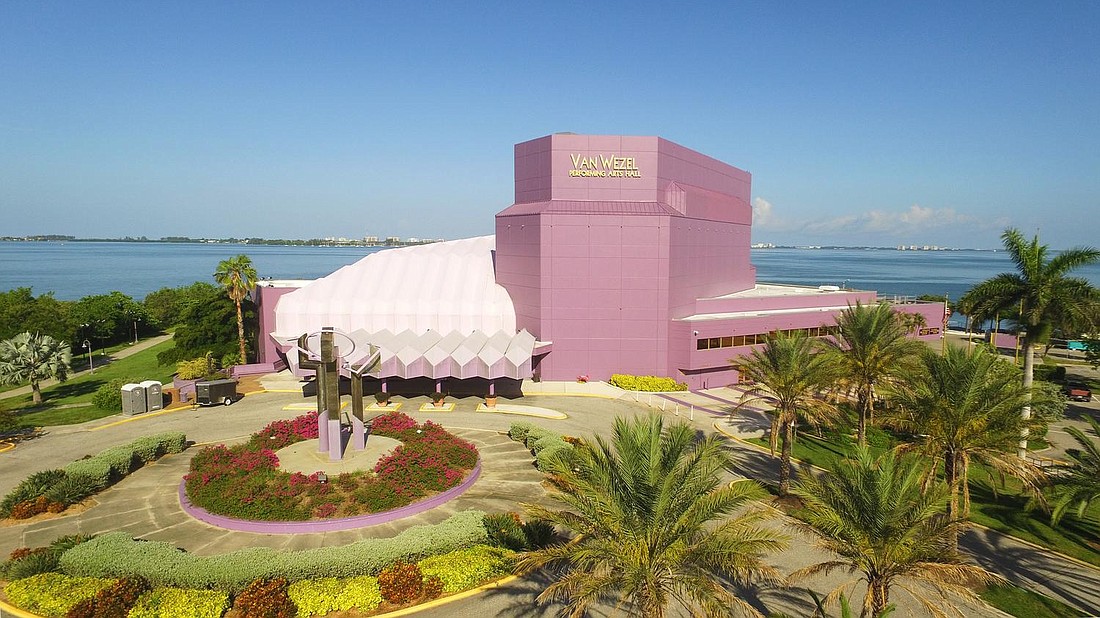- July 26, 2024
-
-
Loading

Loading
 Courtesy image
Courtesy image
Before the city of Sarasota's Purple Ribbon Committee can begin any serious consideration for repurposing the Van Wezel Performing Arts Hall, it first must know a few details about the planned Sarasota Performing Arts Center.
To convert the venue into a complementary facility, the committee needs to know what it is complementing.
That was one of the questions posed to the new Sarasota Performing Arts Foundation CEO Tania Castroverde Moskalenko, who made her first appearance before the committee on March 25.
After introducing herself, Castroverde Moskalenko, with the help of SPAF Chairman Jim Travers, moved through a presentation heavy on concepts but light on particulars.
Still to be determined are the number of seats, whether there will be one or two performance spaces, when conceptual design work will begin and, perhaps most importantly, how much the new SPAC will cost.
All that will be forthcoming in a matter of months, she said, once contract negotiations between the city and Renzo Piano Building Workshop are complete. (The Italy-based architecture firm was selected to design the new facility.)
Committee member Selma Goker Wilson asked for any level of detail that could be shared, such as whether there will be a smaller performance space in the SPAC in addition to the main hall. That could be one of the determining factors in its recommendation to the city about repurposing the Van Wezel.
“I think it would be useful for us to know what is at least projected to happen in the building in terms of spaces,” Goker Wilson said.
A business plan, Castroverde Moskalenko responded, is currently under development and will “hopefully” be completed by mid-summer.
That will include some idea of the cost, which early estimates set at $275 million. Per an interlocal agreement, the SPAC, as part of The Bay, is to be funded 50% by city and county tax increment financing district revenues for the improved value of property surrounding The Bay park, and 50% by the SPAF.
The TIF funding may be a point of contention as county officials claim to have not agreed specifically to allocate revenues to the SPAC.
“One of the reasons we are doing this business plan is because we need to know not just how to raise $200 million, or however much that number is, but we need to know how we're going to operate this in 2030, in 2040 and in 2050,” Castroverde Moskalenko said. “In order to do that, we need to know what those spaces need to be. The initial vision is for there to be two spaces, but the purpose of the business plan is so that we know is what's going to make us not necessarily profitable, but at least to break even and not be in the red.”
That formula would determine whether 2,200 seats or 2,600 seats are needed for the main hall, and 300 seats or 800 seats in a second space, or if there even needs to be a second space. Those decisions will require collaboration between the SPAF, the architect, the city and local performing arts groups that might utilize the spaces.
Castroverde Moskalenko has experience in capital campaigns for performing arts venues. In her prior role as executive director of the Miami City Ballet, she led a campaign to raise $65 million to build a new facility there. But $65 million is a far cry from $200 million if not more, and committee member Robert Bunting questioned whether that amount can be raised here.
“I felt the same way when I went to Miami and had to raise the $65 million,” she said. “And that was just for the ballet, which as you know has a much smaller audience base than a performing arts center. Americans are very, very generous. If the project is inspirational and the project has merit and it will increase the quality of life for this community, if it will improve education, if it will create an economic engine for the community, I think that people are very, very generous and they will support it.”
Projections of total tax increment financing revenues through 2049, which is when the TIF district expires, are $351.7 million, according to Sarasota County. That’s up from just more than $329.2 million projected last year. The city and the county contribute equal shares to The Bay, comprising the public’s 50% share toward both The Bay and, if it is built, the SPAC.
Like the SPAC, the Bay Park Conservancy is responsible for raising half the cost of redeveloping the city-owned 53 acres. As the SPAC site is within The Bay park, it is also eligible for TIF financing. The park itself is projected to cost $200 million to complete, accounting for $100 million of the currently projected $351 million in TIF funds. That leaves, more than adequate funding for half of the SPAC.
TIF revenue projections will vary from year to year based upon assessed values of improved property in the district, taxed paid on the increased value benchmarked against the 2019 tax rolls. Among the properties in the TIF district is The Quay.
Castroverde Moskalenko told the committee the foundation’s capital campaign for the SPAC will begin in late 2024 or early 2025.